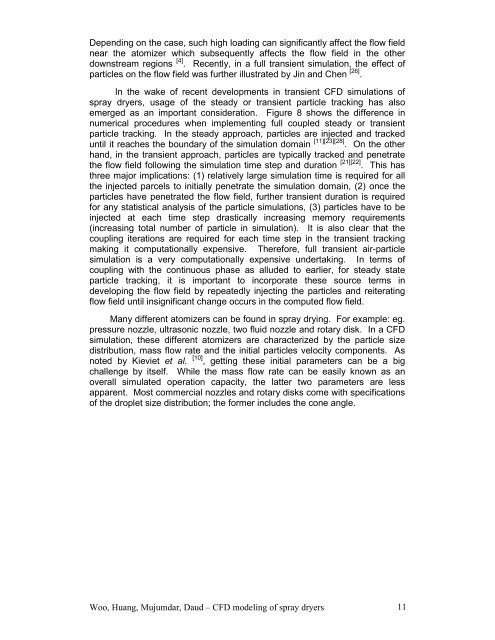Spray Drying Technology.pdf - National University of Singapore
Spray Drying Technology.pdf - National University of Singapore
Spray Drying Technology.pdf - National University of Singapore
Create successful ePaper yourself
Turn your PDF publications into a flip-book with our unique Google optimized e-Paper software.
Depending on the case, such high loading can significantly affect the flow field<br />
near the atomizer which subsequently affects the flow field in the other<br />
downstream regions [4] . Recently, in a full transient simulation, the effect <strong>of</strong><br />
particles on the flow field was further illustrated by Jin and Chen [26] .<br />
In the wake <strong>of</strong> recent developments in transient CFD simulations <strong>of</strong><br />
spray dryers, usage <strong>of</strong> the steady or transient particle tracking has also<br />
emerged as an important consideration. Figure 8 shows the difference in<br />
numerical procedures when implementing full coupled steady or transient<br />
particle tracking. In the steady approach, particles are injected and tracked<br />
until it reaches the boundary <strong>of</strong> the simulation domain [11][23][28] . On the other<br />
hand, in the transient approach, particles are typically tracked and penetrate<br />
the flow field following the simulation time step and duration [21][22] . This has<br />
three major implications: (1) relatively large simulation time is required for all<br />
the injected parcels to initially penetrate the simulation domain, (2) once the<br />
particles have penetrated the flow field, further transient duration is required<br />
for any statistical analysis <strong>of</strong> the particle simulations, (3) particles have to be<br />
injected at each time step drastically increasing memory requirements<br />
(increasing total number <strong>of</strong> particle in simulation). It is also clear that the<br />
coupling iterations are required for each time step in the transient tracking<br />
making it computationally expensive. Therefore, full transient air-particle<br />
simulation is a very computationally expensive undertaking. In terms <strong>of</strong><br />
coupling with the continuous phase as alluded to earlier, for steady state<br />
particle tracking, it is important to incorporate these source terms in<br />
developing the flow field by repeatedly injecting the particles and reiterating<br />
flow field until insignificant change occurs in the computed flow field.<br />
Many different atomizers can be found in spray drying. For example: eg.<br />
pressure nozzle, ultrasonic nozzle, two fluid nozzle and rotary disk. In a CFD<br />
simulation, these different atomizers are characterized by the particle size<br />
distribution, mass flow rate and the initial particles velocity components. As<br />
noted by Kieviet et al. [10] , getting these initial parameters can be a big<br />
challenge by itself. While the mass flow rate can be easily known as an<br />
overall simulated operation capacity, the latter two parameters are less<br />
apparent. Most commercial nozzles and rotary disks come with specifications<br />
<strong>of</strong> the droplet size distribution; the former includes the cone angle.<br />
Woo, Huang, Mujumdar, Daud – CFD modeling <strong>of</strong> spray dryers 11

















